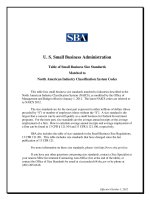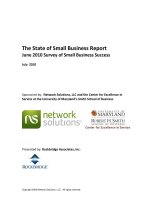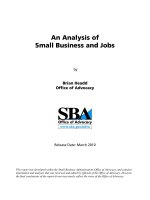the 7 irrefutable rules of small business growth - steven s. little
Bạn đang xem bản rút gọn của tài liệu. Xem và tải ngay bản đầy đủ của tài liệu tại đây (1.97 MB, 257 trang )
TLFeBOOK
The 7 Irrefutable Rules
of
Small
Business
Growth
TLFeBOOK
TLFeBOOK
The 7 Irrefutable Rules
of
Small
Business
Growth
Steven S. Little
John Wiley & Sons, Inc.
TLFeBOOK
Copyright © 2005 by Steven S. Little. All rights reserved.
Published by John Wiley & Sons, Inc., Hoboken, New Jersey.
Published simultaneously in Canada.
No part of this publication may be reproduced, stored in a retrieval system, or
transmitted in any form or by any means, electronic, mechanical, photocopying,
recording, scanning, or otherwise, except as permitted under Section 107 or 108 of
the 1976 United States Copyright Act, without either the prior written permission of
the Publisher, or authorization through payment of the appropriate per-copy fee to
the Copyright Clearance Center, Inc. 222 Rosewood Drive, Danvers, MA 01923,
(978) 750-8400, fax (978) 646-8600, or on the web at www.copyright.com. Requests
to the Publisher for permission should be addressed to the Permissions Department,
John Wiley & Sons, Inc., 111 River Street, Hoboken, NJ 07030, (201) 748-6011, fax
(201) 748-6008.
Limit of Liability/Disclaimer of Warranty: While the publisher and author have used
their best efforts in preparing this book, they make no representations or warranties
with respect to the accuracy or completeness of the contents of this book and
specifically disclaim any implied warranties of merchantability or fitness for a
particular purpose. No warranty may be created or extended by sales representatives
or written sales materials. The advice and strategies contained herein may not be
suitable for your situation. The publisher is not engaged in rendering professional
services, and you should consult a professional where appropriate. Neither the
publisher nor author shall be liable for any loss of profit or any other commercial
damages, including but not limited to special, incidental, consequential, or other
damages.
For general information on our other products and services please contact our
Customer Care Department within the United States at (800) 762-2974, outside the
United States at (317) 572-3993 or fax (317) 572-4002.
Wiley also publishes its books in a variety of electronic formats. Some content that
appears in print may not be available in electronic books. For more information
about Wiley products, visit our web site at www.wiley.com.
Library of Congress Cataloging-in-Publication Data:
Little, Steven S.
The 7 irrefutable rules of small business growth / Steven S. Little.
p. cm.
Includes index.
ISBN 0-471-70760-0 (pbk.)
1. Small business—Management—Handbooks, manuals, etc. I. Title: The 7
irrefutable rules of small business growth. II. Title.
HD62.7.L58 2005
658.02′—dc22
2004022890
Printed in the United States of America.
10987654321
TLFeBOOK
To the memory of
my nephew Dean,
who gave us all the gift of perspective this summer.
TLFeBOOK
TLFeBOOK
vii
C
ONTENTS
Preface: Did I Really Say “Irrefutable”? ix
Acknowledgments xvii
About the Author xix
C
HAPTER
1A Realist’s View of the Small
Business Landscape 1
C
HAPTER
2Are You Really the Entrepreneurial Type? 27
C
HAPTER
3RULE 1: Establish and Maintain a Strong
Sense of Purpose 43
C
HAPTER
4RULE 2: Thoroughly Understand
the Marketplace 69
C
HAPTER
5RULE 3: Build an Effective Growth
Planning System 85
C
HAPTER
6RULE 4: Develop Customer-Driven
Processes 105
C
HAPTER
7RULE 5: Put the Power of Technology
to Work 137
C
HAPTER
8RULE 6: Attract and Keep the Best and
the Brightest 167
C
HAPTER
9RULE 7: See the Future More Clearly 197
Appendix: Personality Tests That Measure
Entrepreneurial Types 217
Index 231
TLFeBOOK
TLFeBOOK
ix
P
REFACE
D
ID
I R
EALLY
S
AY
“I
RREFUTABLE
”?
Y
ea,I sure did. Ir-re-fu-ta-ble. There I said it again.
Without question, this is the one word that best describes
what I’m trying to say. However, like many words, this one
may have different meanings for different readers. To get us
off on the right foot, I want to be sure that you and I are clear
on my meaning. Let me explain.
SOME BACKGROUND
Throughout much of the 1980s and 1990s, I was president of
three different fast-growth businesses. In each case, these
businesses went from pretty small to considerably bigger (but
still pretty small in the grand scheme of things). The biggest
one reached more than $12 million in revenue and 100 em-
ployees, and all three went through significant growth phases.
At a relatively early age, I did learn a few things about what it
takes to grow a small business.
I also learned that I liked talking about small business
growth more than I liked actually doing it. I come from a long
line of teachers and orators, and eventually the pull of that
familial persuader gene proved more than I could resist. I
TLFeBOOK
PREFACE
x
decided in early 1998 (along with my inexplicably under-
standing spouse) to pursue a full-time career as an indepen-
dent consultant and speaker, specializing in the area of
business growth for the privately held business. So far, so
good.
Soon after, people began to hire me. In almost every case,
they hired me based on my experience growing smaller busi-
nesses into bigger ones. That’s what gave me credibility in
their eyes. Whether it was as a speaker or a consultant, it was
my past success that got their attention. I have now spoken di-
rectly with literally tens of thousands of owners and managers
of private enterprises. To this day, people still usually hire me
based on my real-world experience.
But here’s an interesting thing. As I said before, I did learn a
few things about growing businesses while I was doing it. How-
ever, I’ve learned much, much more about the concept of busi-
ness growth since becoming a consultant, speaker,and“expert”
in the field. What I’ve learned, combined with my experience
growing small companies, is really what I bring to the table.
Foryears, I’ve immersed myself in the study of business
growth. Who does it? Why do they do it? Why does this owner
make it work and not that one? What do the academicians
say on the subject? Successful entrepreneurs? Other self-
proclaimed experts? The media? It’s a fascinating subject and
one in which your sources of information are never exhausted.
So what have I learned? For one thing, I’ve learned that
back when I thought I knew everything I could on the subject
of growth, I actually knew very little. I’ve also learned that the
more I know about my chosen field, the less definitive I can
be. In other words, the more I see and hear and experience
what it takes to grow a privately held business, the less able I
am to make sweeping pronouncements and general state-
ments of truth.
TLFeBOOK
Preface
xi
For every small business study that points in a specific di-
rection, there’s invariably another that points in exactly the
opposite direction. I can get consensus from one group of
business owners on one idea, only to be shot down as irrele-
vant by the next. Even some of my own nuggets of wisdom,
slowly unearthed during my many years of digging in the
trenches, have proven to be nothing more than fool’s gold.
But I have found a few concepts that seem to resonate with
people in the know—people who have witnessed sustained,
profitable growth. Through years of dedicated effort (aka trial
and error), I’ve managed to hone in on a few big ideas that
seem to make sense—ideas with which people I respect ap-
pear to agree.
How do I know they agree? It has more to do with what they
don’t say than what they do. On the whole, company leaders
who’ve had even a modest amount of success become stark-
raving “experts.” (Believe me, as a former company president, I
know.) They are never shy about shooting down anyone or
anything that espouses ideas that are contrary to their own ex-
perience. (Believe me, as a speaker and consultant, I know.)
These seven rules of small business growth that I include in
this book are not rules because anyone in particular agrees
with them. Instead, it’s because I can’t find any credible indi-
viduals inclined to disagree with them. To me, that is exactly
what makes them so gosh-darn ir-re-fu-ta-ble. It’s not that
they’re scientifically proven. It’s that no one wants to disprove
them, because almost everyone already agrees with them.
Does that make sense?
Yo u’ll find that I like to make use of analogies, so here goes
the first of many. Everyone seems to agree that a rose is beau-
tiful. The notion that a rose is beautiful is irrefutable, despite
the fact that it would be impossible to prove. Sure, I guess we
could conduct some type of poll about attitudes toward rose
TLFeBOOK
PREFACE
xii
beauty by various demographic groups, culminating in a sta-
tistical proof of general rose beauty across the human race.
No one does this, though, because it’s silly. A rose is beautiful,
and everyone knows it.
The rules I present here are important, and everyone “in
the know” knows it. They are irrefutable.
OTHER STUFF YOU NEED TO
KNOW BEFORE WE GET STARTED
This is not a checklist book. Every year, I speak to literally tens
of thousands of business owners and managers interested in
growth. After the event, people often call or e-mail me with
additional questions. Without a doubt, the second most com-
mon question people ask me is, “What book can I buy that
will tell me how to grow my business?” (By the way, the most
common is, “How can I become a speaker?” That answer I’ll
save for another day.)
The book question is an interesting one for a couple of rea-
sons. First, they never say “read.” It’s always what book should
I “buy.” Perhaps I’m thinking about it too much, but the ques-
tion implies (to me, anyway) that the mere act of purchasing
the book will somehow help your business grow. My editor es-
timates that 20 percent or less of all business books purchased
are ever read.
Second, the idea that someone has written a book that can
give you specifics on how to grow your business is ludicrous.
J. Paul Getty (a pretty successful growth guy) once said, “No
one can possibly achieve any real and lasting success or ‘get
rich’ in business by being a conformist.” While a guaranteed
17-point growth guide checklist would undoubtedly be pop-
ular, it would also be irresponsible. Checklists don’t grow
businesses.
TLFeBOOK
Preface
xiii
Instead of offering a checklist, this book identifies and ex-
amines those areas in which growth organizations concentrate
their efforts. It is within these areas that the real magic hap-
pens, and that magic is up to you: the innovations and the
revelations, the evolutions and the revolutions, doing it differ-
ently than anyone before, executing better than anyone has be-
fore. This is the stuff of real, sustained, profitable growth. In
other words, I’m not telling you what to do; I’m suggesting
where you should be looking to do it. At the end of each
“rules” chapter, I have listed some suggested next steps. In no
way should these be taken as specific suggestions. They are
merely examples of exercises and questions you might con-
sider to help you find your unique perspective on opportunity.
This is not a financial book. Any organization, big or small,
needs to build a system that is able to deliver timely and con-
sistent information about the financial health of the organiza-
tion to the people who run the organization. Every business I
ever headed produced a daily one-page “morning report” that
highlighted the most important data for the day, month-to-
date, and year-to-date. Revenue, orders, accounts payable, ac-
counts receivable, inventory levels, and the so-called “quick
ratio” (a measure of liquidity) were just a few of the numbers
we considered every day. An Income Statement, a Balance
Sheet, and a Cash-Flow Statement were produced and studied
every month, without exception. I strongly suggest you do the
same, because it will help you grow your business.
Having said that, this is the last you’ll hear about finan-
cials in this book. The truth is that for many, if not most,
business owners, it’s a rather dry subject. It’s also a topic that
has been covered very well by many others over the years.
Both of these considerations had some bearing on my deci-
sion to limit its direct exposure here. However, I would
TLFeBOOK
PREFACE
xiv
maintain that financials play a critical role throughout this
book, although they are not highlighted.
Finding and keeping the best and the brightest when you
can’t make payroll due to poor cash flow management deci-
sions is impossible. How can you expect to better leverage the
power of technology when you can’t identify the problem
areas on your P&L Statement? One of the most important
customer-driven processes for most companies is the timely
delivery of products or services. Properly managing your in-
ventories, be it products, parts, or man-hours, is an important
financial consideration with huge customer satisfaction im-
plications linked to it.
I think you get the idea. Each of the seven rules in this book
depends on your organization’s ability to monitor and inter-
pret its financial data. While you don’t have to be a CPA, it re-
ally helps if you know how to keep score. As we say here in
North Carolina, “’nuff said.”
RULES REALLY ARE MADE TO BE BROKEN
The word rule, like irrefutable, has many meanings and con-
notations. Look it up in your thesaurus, and you’ll find simi-
lar words such as decree, imperative, and law—pretty strong
stuff. You’ll also find some synonyms much closer to my
meaning in this book, such as conventional, usual, and cus-
tomary. For example, “In growth companies, hard work is the
rule, not the exception.” That’s how I want you to take these
so-called rules—not as laws to which you need to surrender
but, instead, general courses of action that seem to work for
many others.
The last impression I want to leave with anyone is that
youmust follow these seven rules or you will be unable to
grow successfully. That’s simply not the case. My intent here
is to offer insights into the broad areas in which I’ve seen
TLFeBOOK
Preface
xv
innovation and execution make a real difference in privately
held companies. From these insights, it’s my hope that you
will discover your own new ways to realize the full potential
of your business.
PROFIT IS IMPORTANT
As I travel the country speaking to groups of entrepreneurs,
there’s often one person at the end of my time who wants to
play “stump the speaker.” These are usually good-natured
people who aren’t trying to raise a big fuss. But they do want
to see if they can trip up this “expert” with the microphone.
Over the years, like a stand-up dealing with hecklers, I’ve
heard most of the comments meant to throw me. By far the
most common example is something like, “Steve, you’ve talked
a lot today about growth. What about profit? Don’t you think
profit is more important than growth?”
So here’s the answer I give them: an emphatic “yes”and “no.”
Yes, in this sense: For those people who don’t want to grow,
maximizing profitability is the most important thing. Big
businesses often milk their brands for profit when growth be-
comes too difficult or expensive. Many small business owners
also have good reasons they might not want to grow. They
may be happy with their current level. They may have other
interests outside the business that keep them busy. They
might not want employees. Whatever their reasons, they, too,
look for ways to milk their business for profits. I have no
problem with that stance. It’s a perfectly reasonable way to go
about managing your business. I caution only against the po-
tential for undernourishment that might cause the milk to
dry up sooner then anticipated.
However, for the privately held business determined to
grow, profit is not more important than growth. In fact, you
simply can’t divorce one from the other. Growth cannot be
TLFeBOOK
PREFACE
xvi
achieved indefinitely without profit. Profit becomes increas-
ingly difficult to perpetuate for any length of time without
growth. Throughout this book, I use words like sustainable
and successful to modify the word growth. When I use those
words, you can assume I’m talking about profitable growth.
Profits are a great way to measure success. Profits are often the
best way to fund organic growth. Profits help us measure our
performance. Profits matter, but not more than growth. In-
deed, they are ultimately the same thing.
What Do I Mean When I Say “Growth?”
However you choose to measure or define growth is probably
how I would measure or define it. If you decide to pursue a
growth rate of 3 percent next year, then that’s your definition
of growth as it relates to your business. I would not try to con-
vince you otherwise on such a personal decision. If your goal
is to make the Inc. 500 list and grow over 1,000 percent over
the next five years, then that’s also a legitimate benchmark
of growth. Either way, the rules I’ve presented here and the
lessons I’ve shared from my experience will, I believe, help
you. You see, I think growth is as much a mind-set as it is a
fixed goal. The foundations on which you build growth are
the same, regardless of the size or duration of the plan.
If you are ready to grow your business, I am confident this
book will help you. If it can offer just one really solid idea
that makes a significant contribution to your growth efforts,
I will feel I’ve accomplished my goal for this book. If that
happens, I hope you’ll e-mail me to let me know:
TLFeBOOK
A
CKNOWLEDGMENTS
I
fyou are included in this book, I sincerely and profusely
thank you. Whether you are a client, an acquaintance, a
vendor, a friend, or a family member, I appreciate your letting
me tell your story.
There are a couple of people who aren’t named in the book,
but without whom this endeavor would never have made its
deadline. Tim Leffel is a kindred spirit, talented freelance edi-
tor, Yucatecan neighbor, and new friend. I can only hope his
wife and daughter aren’t cursing my name too badly these
days. Amy Little, my wife of 20 years, has been the logistics ex-
pert,fact checker, and BS detector on this project from the
start. Without these two, there would be no book.
I am also in great debt to Jeffrey Gitomer for introducing
me to many people, including my new editor and buddy, Matt
Holt, and all the other great folks at Wiley. Tamara Hummel is
one of the nicest people I’ve ever met and a true pleasure to
work with. I can only assume that I will feel the same way
about Shannon Vargo when I meet her. Based on our phone
work, that will undoubtedly be the case. Her edits have signif-
icantly improved this book. Martha Mangelsdorf has also
contributed immensely to this final product, with both her
keen eye for style and a thorough understanding of issues sur-
rounding small business. Thanks for working on such a tight
time crunch, Martha.
Finally, I would like to say thanks to my son Tyler, who
hasn’t seen much of his dad the past couple of months. Let’s
get to Pan y Vino soon and blow Dad’s diet!
xvii
TLFeBOOK
TLFeBOOK
xix
A
BOUT THE
A
UTHOR
S
tevenS.Little is a much sought-after writer and consul-
tant on the subject of business growth and the future of
opportunity. As Senior Consultant for Inc. since 1998, he
speaks to thousands of owners and managers of growing or-
ganizations each year.
He also regularly speaks for some of the world’s leading
companies, institutions, and associations, including UPS,
Sprint, Microsoft, Bank of America, Young Entrepreneurs’
Organization, and chambers of commerce around the world.
His style has been described as “real world,” “highly credible,”
and “uniquely engaging.” To see him in action, check out his
web site at www.stevenslittle.com. You’ve probably never seen
anything quite like it.
Through the 1980s and 1990s, Steve was president of three
fast-growth companies. Both FAME, Inc. and ERB Industries
achieved profitable growth rates of over 500 percent during
his tenure. As president of The Queensboro Shirt Company,
Steve helped to build one of the country’s most successful
sites for Internet commerce.
Steve began his career in advertising with Foote Cone &
Belding and DKB Advertising. Steve is a graduate of Miami
University and has studied at the Institute for Management
Development in Lausanne, Switzerland, and The Future Stud-
ies Masters Program at the University of Houston (Clear
Lake). Steve and his wife Amy and son Tyler live in both sunny
Wilmington, North Carolina, and historic Mérida, Mexico.
TLFeBOOK
TLFeBOOK
1
1
AR
EALIST
’
S
V
IEW
OF THE
S
MALL
B
USINESS
L
ANDSCAPE
S
mall business success plays a vital role in this country’s
mythology. You know the stories: the poor immigrant with
50 cents in his pocket who goes on to run a chain of 20 restau-
rants, the husband and wife who toil away for years and get
the one big break that makes them millionaires, the grandma
who makes cookies in her kitchen and ends up running a
company with hundreds of employees, and the two nerds who
create a software program in their garage and then sell it to
IBM for a few billion dollars.
We love these stories because they capture the American
spirit. The rugged individual who triumphs against all odds is
quintessentially “us.” Yet, growing a company is by no means a
Horatio Alger yarn, and the myths are often offset by a more
sobering reality. A special small business report in the Wall
Street Journal in 2004 led off with the following:
Last year, the U.S. gave birth to over half a million new firms.
Equally telling, nearly the same number of firms closed their
TLFeBOOK
THE 7 IRREFUTABLE RULES OF SMALL BUSINESS GROWTH
2
doors in the same period. What this means is however much we
glorify and obsess over success in the workplace, the notion of
failure must go hand in hand with it.
That’s an important point. While there are indeed factors
that make it a good time to be an entrepreneur in America,
there are also factors that make it a challenging time to be
running your own business. In fact, if someone asked me
whether it is the best of times or the worst of times for small
business in America, I could argue either point of view. In my
opinion, the current state of small business could be accu-
rately described as both the best and worst of times—and I
explain why later in this chapter. But first, let’s take a realistic
look at what the term small business encompasses.
WHAT IS SMALL BUSINESS?
Is there really any such thing as small business? The term con-
jures up a wide range of imagery. The U.S. Small Business Ad-
ministration (SBA) defines both a sole proprietorship and a
firm with 499 employees—and everything in between—as
being a small business. An individual selling quilts at a
monthly flea market would seemingly have little in common
with a 400-person software design firm. Obviously, lumping
all small businesses like these together is ridiculous. In some
ways, the SBA has admitted as much, in that its own defini-
tions for what constitutes a small business run for 29 pages. (A
2004 effort to simplify the description continues.)
So here are the facts. You may think you don’t need to know
this to grow your business, but I encourage you to stay with
me. The U.S. Census Bureau 2002 report showed that there
were 22 million small businesses operating in the United
States. However, look at the numbers a little more closely, and
TLFeBOOK
A Realist’s View of the Small Business Landscape
3
you’ll quickly see that approximately 17 million of these busi-
nesses don’t have any employees. Some are simply shells set up
by accountants and attorneys for tax purposes. Others are en-
terprises that can’t or don’t want to get any larger than they al-
ready are. Despite not having any employees, you are probably
a small business if:
•You sell candles, cleaning products, or cosmetics on a
very part-time basis and make a few hundred dollars in
profit per year.
•You lost your job in a corporation but got hired by the
same company as an independent contractor.
•You are 70 years old and retired, but you do a little con-
sulting on the side.
•You have a booth at local art festivals to sell your hand-
made crafts.
•You buy things and “flip” them for a profit: cars, rental
houses, collectibles, and so on.
•You live off the income from your investment activity.
There’s nothing wrong with these enterprises. They make
money for somebody, so the IRS rightfully considers them
more than a hobby. Some of them even give people a pretty
luxurious lifestyle. But these “small businesses” seldom lead to
more employees being hired, and very few of them grow be-
yond a one-person entity. In many cases, the person conduct-
ing the work doesn’t want the business to grow. The intention
is to make a living or earn a little extra spending money.
Other nonemploying firms are truly small businesses inter-
ested in growth. The following are examples of the nonem-
ploying firms interested in growth versus the comparatively
static types previously listed:
TLFeBOOK
THE 7 IRREFUTABLE RULES OF SMALL BUSINESS GROWTH
4
•You’ve worked in the same industry for a number of
years, and you’ve recently decided to forge out on your
own to build the proverbial “better mousetrap.”
•You are a skilled craftsperson who hasn’t needed another
person yet but hopes to reach that point someday soon.
•You’ve been in business for quite a number of years as a
sole practitioner but are now giving serious considera-
tion to expansion.
•You’ve been in business only a short time but have always
had a goal of growing your customer/client base.
•After years of hitting singles as a one-person business, a
customer approaches you with a home-run opportunity
that you can’t fulfill by yourself.
For the purposes of this book, I assume that a business in-
terested in growth either is or plans to be an employing firm.
Are there examples of one-person firms that achieve growth
through outsourcing and “virtual teams”? Absolutely! Tech-
nology is making this easier and easier every day. But at this
point, these companies are in the distinct minority.
This book targets those who want to grow their business.
Throughout, I assume that you already have a small busi-
ness—probably with employees—or that you’re intending to
get to that point sooner rather than later. Most of the observa-
tions I make are aimed at helping you grow a business that
probably has at least a handful of employees but hasn’t gotten
so big that it has taken on a corporate life of its own. It’s in the
size range of roughly 5 to 99 employees that a lot of the im-
portant growth milestones take place in a company’s develop-
ment. However, these numbers are rather arbitrary and are
used primarily because the government divides up segments
of data at these points. If your business is smaller than five
employees—but you’re trying to grow—you’ll also find just as
TLFeBOOK









